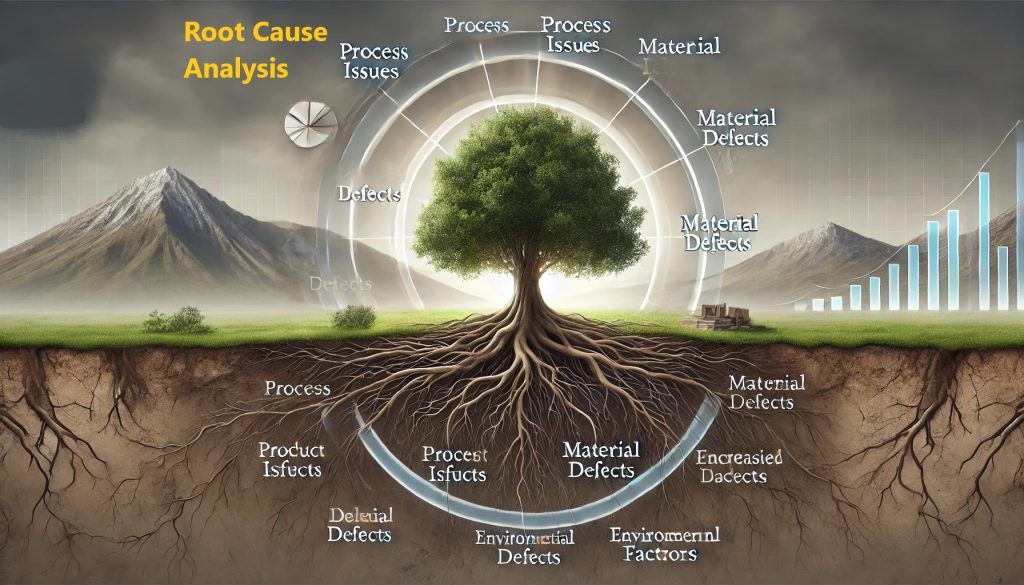Root Cause Analysis (RCA) systematically identifies the underlying causes of problems or failures. Rather than just addressing symptoms, RCA focuses on uncovering the root causes that lead to issues. This method helps in preventing the recurrence of problems by implementing corrective actions aimed at the source of the issue.
Understanding the importance of RCA is crucial in maintaining and improving operational efficiency. By identifying and addressing root causes, organizations can eliminate the possibility of recurring issues, which reduces downtime and associated costs. Moreover, RCA enhances decision-making by clearly explaining what went wrong and why, enabling the implementation of more effective solutions.
Various industries, from manufacturing and healthcare to IT and aviation, widely apply Root Cause Analysis. In manufacturing, teams often use RCA to identify defects in production processes, ensuring higher quality products. For healthcare, it helps in investigating medical errors to improve patient safety. In IT, teams employ RCA to diagnose system failures or cybersecurity breaches, reducing the risk of future incidents. Across all these industries, the consistent application of RCA contributes to improved performance and reliability.
Types of Root Cause Analysis Techniques
Root Cause Analysis (RCA) employs various techniques to systematically identify and address underlying issues. Among these, the Fishbone (Ishikawa) Diagram is particularly effective for visualizing complex problems. This technique categorizes potential causes of a problem, organizing them into key areas such as people, processes, materials, and machinery. The Fishbone Diagram helps teams brainstorm and systematically explore all possible causes, making it easier to pinpoint the root issue.
Another widely used technique is the 5 Whys. This simple yet powerful method involves repeatedly asking “why,” usually five times, until uncovering the fundamental cause of a problem. The 5 Whys technique is particularly useful for quickly getting to the heart of a problem without overcomplicating the analysis. Its straightforward approach ensures that teams do not overlook underlying causes.
Failure Mode and Effects Analysis (FMEA) is another comprehensive RCA tool that systematically evaluates potential failure modes within a process. FMEA identifies possible failures, assesses their impact, and prioritizes them based on their severity and likelihood. This proactive technique is valuable in preventing issues before they occur, especially in industries where safety and reliability are critical.
Pareto Analysis is another valuable technique, focusing on the principle that a small number of causes often account for the majority of problems. By identifying and addressing these key causes, organizations can achieve the greatest impact with their corrective actions. Pareto Analysis is particularly effective when resources are limited, helping teams prioritize their efforts for maximum efficiency.
These RCA techniques, each with its strengths, can be tailored to fit different scenarios and industries. By choosing the appropriate method, organizations can effectively uncover root causes, implement solutions, and prevent future issues.
Steps in Conducting Root Cause Analysis
Conducting Root Cause Analysis (RCA) begins with clearly identifying the problem that needs resolution. This initial step is crucial because it sets the direction for the entire analysis. A well-defined problem statement ensures that the focus remains on addressing the right issue. Without a clear understanding of the problem, efforts might be misdirected, leading to ineffective solutions.
Following problem identification, the next step involves gathering and analyzing relevant data. Accurate data collection is essential for understanding the problem’s scope and impact. This data provides a factual basis for the analysis, allowing teams to assess the problem objectively. Through careful examination, patterns or trends that contribute to the issue can be identified, guiding the analysis toward potential causes.
Once the data is analyzed, the focus shifts to identifying potential causes. At this stage, various RCA techniques, such as Fishbone Diagrams or 5 Whys, help explore all possible contributing factors. It’s important to consider all areas that might influence the problem, ensuring no root cause is overlooked. By systematically narrowing down the list of potential causes, teams can concentrate their efforts on the most likely sources of the issue.
Finally, verifying the root cause is critical before implementing any corrective actions. Verification involves testing or further analysis to confirm that the identified cause is indeed responsible for the problem. This step prevents unnecessary changes and ensures that the corrective measures will effectively resolve the issue. Once verified, teams can proceed confidently, knowing they are addressing the true root cause, thus preventing future occurrences of the problem.
Tools and Software for Root Cause
Root Cause Analysis (RCA) relies on various tools and software to facilitate the identification and resolution of underlying issues. Popular RCA tools, such as Fishbone Diagrams and Pareto Analysis, are widely used for their simplicity and effectiveness. These tools help visualize complex problems, making it easier to identify and categorize potential causes. Additionally, tools like the 5 Whys technique provide a straightforward method for drilling down to the root cause by repeatedly asking “why” until the fundamental issue is uncovered.
Software solutions have also become integral to conducting RCA, offering advanced features that enhance the analysis process. Many RCA software tools provide automated data collection and analysis capabilities, streamlining the identification of patterns and trends. Some platforms integrate with other business systems, enabling seamless data flow and real-time updates. This integration ensures that all relevant information is available for a thorough and accurate analysis. Moreover, these software solutions often include reporting features, allowing teams to document findings and track the effectiveness of corrective actions over time.
Integrating RCA
Integrating RCA with other quality management systems further amplifies its impact on organizational improvement. RCA can be seamlessly combined with methodologies like Six Sigma, Lean, and ISO standards to create a comprehensive quality management framework. This integration ensures that RCA findings are not only used to address immediate issues but also contribute to broader continuous improvement efforts. For example, insights gained from RCA can inform process optimization initiatives within a Lean Six Sigma program, driving more significant and sustained improvements.
Furthermore, combining RCA with other quality management systems allows organizations to create a unified approach to problem-solving. By aligning RCA efforts with overarching quality goals, businesses can ensure that their corrective actions support long-term strategic objectives. This holistic approach enhances the effectiveness of RCA, making it a critical component of an organization’s overall quality management strategy.
Challenges in Root Cause Analysis
Root Cause Analysis (RCA) presents several challenges that can hinder its effectiveness if not addressed properly. One of the most common pitfalls is rushing through the analysis without thoroughly exploring all potential causes. This tendency often leads to superficial conclusions that fail to address the true root of the problem. Consequently, issues may reoccur, wasting resources and time.
Another challenge in RCA is the tendency to rely on assumptions rather than facts. When teams make decisions based on preconceived notions, they risk overlooking critical data or misinterpreting the situation. Ensuring that the analysis is grounded in accurate data is essential for producing meaningful and actionable insights. This requires careful data collection, rigorous analysis, and a commitment to letting the evidence guide conclusions.
Maintaining objectivity is also crucial in Root Cause Analysis. Biases, whether conscious or unconscious, can skew the analysis, leading to incorrect conclusions. Teams must strive to remain impartial, focusing on data-driven results. Encouraging diverse perspectives and fostering an environment where all team members can voice their insights can help mitigate biases and enhance the overall accuracy of the analysis.
Ensuring accuracy in RCA also involves verifying the identified root causes before implementing corrective actions. Skipping this verification step can result in addressing symptoms rather than the actual issue. By testing or further analyzing the suspected root cause, teams can confirm that their findings are correct, leading to more effective solutions that prevent future problems.
In conclusion, while Root Cause Analysis is a powerful tool for problem-solving, it requires careful execution to avoid common pitfalls. By ensuring objectivity, relying on accurate data, and thoroughly verifying conclusions, organizations can maximize the effectiveness of their RCA efforts and achieve more sustainable improvements.
Benefits of Implementing Root Cause Analysis
Implementing Root Cause Analysis (RCA) offers significant benefits, particularly in improving process efficiency. By identifying and addressing the underlying causes of issues, organizations can streamline operations and eliminate inefficiencies. This focus on root causes ensures that corrective actions are more effective, reducing the need for repeated interventions. Consequently, processes become more reliable, leading to smoother workflows and higher productivity.
Another major benefit of RCA is its ability to reduce recurring issues and associated costs. When problems are addressed at their source, the likelihood of recurrence decreases significantly. This not only improves product and service quality but also reduces the costs related to rework, scrap, and downtime. Over time, these savings can be substantial, positively impacting the organization’s bottom line.
Moreover, RCA fosters a culture of continuous improvement within the organization. As teams become more adept at identifying and resolving root causes, they contribute to ongoing enhancements in processes and systems. This proactive approach leads to sustained improvements, allowing the organization to maintain a competitive edge in the market.
In summary, the benefits of implementing Root Cause Analysis extend beyond immediate problem-solving. By improving process efficiency and reducing recurring issues, RCA drives long-term success and cost savings, making it a vital tool for any organization focused on quality and operational excellence.
Case Studies and Real-World Examples
Case studies from various industries highlight the success of Root Cause Analysis (RCA) in resolving complex issues. For instance, in the manufacturing sector, a company facing frequent equipment failures used RCA to identify a recurring maintenance oversight as the root cause. By addressing this issue, they reduced downtime and increased production efficiency. Similarly, in healthcare, RCA helped a hospital identify communication gaps as the root cause of medication errors. Implementing targeted communication protocols drastically reduced these errors, improving patient safety.
However, RCA is not without its challenges. Some organizations have experienced failures in RCA due to a lack of thorough investigation or reliance on assumptions. For example, a tech company faced repeated system crashes because they prematurely concluded that software bugs were the root cause. A deeper RCA later revealed that the actual issue was hardware-related, emphasizing the importance of exhaustive analysis. This lesson underscores the need for diligence and objectivity in RCA to avoid misdiagnosis and ineffective solutions.
Lessons from both successful and failed RCA implementations provide valuable insights. Successful cases demonstrate the importance of a systematic approach, while failures highlight the risks of incomplete analysis. These experiences reinforce the critical role of thorough data collection, objective evaluation, and verification in ensuring RCA’s effectiveness. In conclusion, real-world examples illustrate RCA’s potential to drive significant improvements, but they also remind us of the importance of careful and accurate application.
Root Cause Analysis in Continuous Improvement Programs
Root Cause Analysis (RCA) plays a vital role in continuous improvement programs like Lean, Six Sigma, and Kaizen. Integrating RCA with these methodologies enhances their effectiveness by systematically identifying and eliminating the root causes of inefficiencies. For instance, within Lean and Six Sigma frameworks, RCA helps pinpoint the specific factors contributing to waste or defects. This integration ensures that improvement efforts address fundamental issues, leading to more sustainable and impactful outcomes.
Moreover, RCA aligns seamlessly with Kaizen’s focus on incremental improvements. By continuously identifying and resolving root causes of problems, organizations can achieve ongoing enhancements in their processes. RCA provides the structure needed to ensure that each small improvement is based on a solid understanding of the underlying issues, thus reinforcing the Kaizen philosophy of gradual, consistent progress.
RCA also plays a critical role in building a culture of continuous improvement. When RCA is embedded in daily operations, it encourages employees to think critically about problems and their solutions. This focus on understanding and addressing root causes fosters a proactive mindset, where teams are constantly looking for ways to improve. Over time, this approach transforms the organizational culture, making continuous improvement a core value.
In conclusion, integrating Root Cause Analysis with Lean, Six Sigma, and Kaizen not only enhances these methodologies but also supports the development of a culture dedicated to continuous improvement. By systematically addressing root causes, organizations can achieve lasting improvements and maintain a competitive advantage in their industry.
Best Practices for Effective RCA
Effective Root Cause Analysis (RCA) requires adherence to best practices that ensure thoroughness and accuracy. One crucial tip is to involve a diverse team in the analysis. Bringing together individuals with different expertise and perspectives fosters a more comprehensive understanding of the problem. This collaborative approach helps identify all potential causes and prevents overlooking critical factors.
Another key practice is to rely on data rather than assumptions. Accurate data collection and analysis are essential for identifying the true root cause. Teams should focus on gathering relevant information from various sources and using objective methods to interpret the data. This evidence-based approach reduces the risk of misdiagnosis and ensures that corrective actions target the actual issue.
Ensuring follow-through on RCA findings is equally important. Identifying the root cause is only the first step; implementing corrective actions is what drives real improvement. Organizations should establish clear action plans based on RCA results, assigning responsibilities and setting timelines for implementation. Regular follow-up meetings can help track progress and address any obstacles that arise during the implementation phase.
In addition, it’s vital to document the entire RCA process, including findings, decisions, and actions taken. This documentation not only provides a record for future reference but also ensures accountability. Sharing RCA results and successes with the broader organization can also reinforce the importance of the process and encourage a culture of continuous improvement.
Conclusion
In conclusion, best practices for effective Root Cause Analysis involve conducting a thorough, data-driven analysis and ensuring follow-through on findings. By adhering to these practices, organizations can achieve meaningful and lasting improvements, enhancing overall efficiency and performance.



